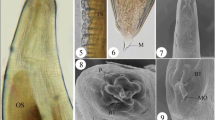Abstract
A majority of Kudoa species infect the somatic muscle of fish establishing cysts. Because there is no effective method to detect infected fish without destroying them, these parasitised fish reach the consumer. The elevated humoral responses detected previously by us in BALB/c mice immunised with Kudoa sp. pseudocyst extracts and the high IgG1 and IgE levels induced by the oral administration of Kudoa pseudocysts to BALB/c mice showed the possible immunopathological effects in man from the ingestion of Kudoa-infected fish. In this work, we investigated the seroprevalence of anti-Kudoa sp. antibodies in a Spanish healthy population and the possible association between the manifestation of allergic reactions after fish consumption and the humoral responses to Kudoa sp. antigens. Specific anti-Kudoa sp. antibody levels in sera of patients diagnosed with several digestive pathologies were also determined, studying their possible association with the alteration of analytic parameters in these patients.


Similar content being viewed by others
References
Barja JL, Toranzo AE (1993) Myoliquefaction post-mortem caused by the myxosporean Kudoa thyrsites in reared Atlantic salmon in Spain. Bull Eur Assoc Fish Pathol 13:86–88
Bayne CJ, Boswell CA, Yui MA (1987) Widespread antigenic cross-reactivity between plasma proteins of a gastropod, and its trematode parasite. Dev Comp Immunol 11:321–329
Bradford M (1976) A rapid and sensitive method for the quantification of microgram quantities of protein utilizing the principle of protein-dye-binding. Anal Biochem 72:248–254
Colton TH (1974) Statistics in medicine. Little, Brown and Co., Boston, MA
Harvey RF, Bradshaw JM (1980) A simple index of Crohn’s disease activity. Lancet 8:514
Holliman A (1994) Sea trout, Salmo trutta, a new host for the myxosporean Kudoa thyrsites (Gilchrist)? Vet Rec 134:524–525
Kabata Z, Whitaker DJ (1986) Distribution of two species of Kudoa (Myxozoa: Multivalvulida) in the offshore population of the Pacific hake Merluccius productus (Ayres 1855). Can J Zool 64:2103–2110
Lennard-Jones JE (1989) Classification of inflammatory bowel disease. Scand J Gastroenterol 24:2–6
Martínez de Velasco G, Rodero M, Zapatero L, Cuéllar C (2002) Humoral immune responses induced by Kudoa sp. (Myxosporea: Multivalvulida) antigens in BALB/c mice. Mem Inst Oswaldo Cruz 97:1091–1095
Martínez de Velasco G, Cuéllar C (2003) Humoral immune responses induced by Kudoa sp. (Myxosporea: Multivalvulida) in BALB/c mice: oral administration, immunization and cross-reactions with Myxobolus aeglefini (Myxosporea: Bivalvulida). Parasite Immunol 25:449–456
Morado F, Sparks AK (1986) Observations on the host–parasite relations of the pacific whiting, Merluccius productus (Ayres), and its two myxosporidean parasites, Kudoa thyrsites (Gilchrist 1924) and K. paniformis (Kabata & Whitaker 1981). J Fish Dis 9:445–455
Moran JD, Margolis L, Webster JM, Kent ML (1999) Development of Kudoa thyrsites (Myxozoa: Myxosporea) in netpen-reared Atlantic salmon determined by light microscopy and a polymerase chain reaction test. Dis Aquat Org 37:185–193
Muñoz P, Palenzuela O, Álvarez-Pellitero P, Sitjà-Bobadilla A (1999) Comparative studies on carbohydrates of several myxosporean parasites of fish using lectin histochemical methods. Folia Parasitol 46:241–247
Patashnik M, Groninger HS Jr, Barnett H, Kudo G, Koury B (1982) Pacific Whiting, Merluccius productus. Abnormal muscle texture caused by myxosporidian-induced proteolysis. Mar Fish Rev 44:1–12
Slifkin M, Doyle RJ (1990) Lectins and their application to clinical microbiology. Clin Microbiol Rev 3:197–218
Stehr C, Whitaker DJ (1986) Host–parasite interaction of the myxosporean Kudoa paniformis (Kabata & Whitaker 1981) and Kudoa thyrsites (Gilchrist 1924) in the muscle of the Pacific whiting, Merluccius productus (Ayres): an ultrastructural study. J Fish Dis 9:505–517
Tsuyuki H, Williscroft SN, Kabata Z, Whitaker DJ (1982) The relationship between acid and neutral protease activities and the incidence of soft cooked texture in the muscle tissue of Pacific hake (Merluccius productus) infected with Kudoa paniformis and/or K. thyrsites, held for varying times under different pre-fresh chilled storage conditions. Fish Aquat Sci Can Tech Rep 1130:39
Whitaker DJ, Kent ML (1991) Myxosporean Kudoa thyrsites: a cause of soft flesh in farm-reared Atlantic salmon. J Aquat Anim Health 3:291–294
Yamaga KM, Kubo RT, Etlinger HM (1978) Studies on the question of conventional immunoglobulin in thymocytes from primitive vertebrates: II. Delineation between Ig-specific and cross-reactive membrane components. J Immunol 120:2074–2079
Acknowledgements
This work was supported in part by research grants PR238/00-9444 (DANONE, S.A.) and PR27/05-13950 (BSCH). We also are grateful to Luis García Palacios and Dr. Gutiérrez Ramos for collecting the serum samples. The experiments comply with the current laws of Spain.
Author information
Authors and Affiliations
Corresponding author
Rights and permissions
About this article
Cite this article
Martínez de Velasco, G., Rodero, M., Chivato, T. et al. Seroprevalence of anti-Kudoa sp. (Myxosporea: Multivalvulida) antibodies in a Spanish population. Parasitol Res 100, 1205–1211 (2007). https://doi.org/10.1007/s00436-006-0390-x
Received:
Accepted:
Published:
Issue Date:
DOI: https://doi.org/10.1007/s00436-006-0390-x



